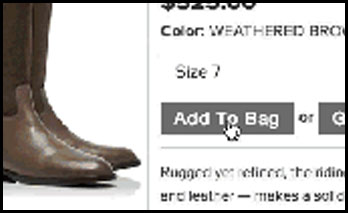Save 50% on a 3-month Digiday+ membership. Ends Dec 5.

The banner ad is one of digital advertising’s oldest tools — it turned 20 in October. Yet it’s also one of the industry’s most maligned. The ubiquitous banner ad, critics say, is chiefly ignored by consumers because it’s just not very helpful. But one sector is working to change that.
Online retailers (and the agencies that serve them) are reinventing banner ads with new technology and personalization tactics to put the customer’s shopping experience first. All in the interest of moving merchandise, of course.
“One of the experiences we’ve worked really hard to develop and scale globally is our ecommerce ads,” said Kristin Mariani, a spokesperson for Amazon Media Group. The standard-sized ads integrate Amazon shopping features and functionality into standard banner sizes — video product tours, for example, plus add-to-cart or add-to-wish-list functions.
“Putting information like customer ratings and reviews, and features like ‘Clip Coupon’ right in the banner makes it easy for customers to take a shopping action right there,” she said, adding the units typically perform 20 to 30 percent better across key metrics like click-through rate, visits to the product page and indexed purchase lift. And because the ads are served across Amazon’s own platform, it’s easier for clients to tie those engagements to performance overall.
“One of the most successful units we have seen recently is the ‘subscribe and save’ unit,” said Thomas Stelter, vp of emerging solutions at creative agency POSSIBLE. The agency employs Amazon units primarily for its CPG clients, one of whom saw a 300 percent increase in subscriptions using the banner, Stelter said.
To engage consumers, first be useful
Several agencies with eCommerce interests are also working to increase banner ad utility.
“Consumers want a seamless, frictionless shopping across the Web,” says Jimmy Donlon, svp of business development at Shopbeam, which has developed a proprietary banner-based tool to enable consumers to load one shopping cart on different websites.
“There needs to be an experience that allows consumers to buy across the Web wherever they feel inspired to shop.”
Increasing the banner ad’s usefulness is at the heart of Shopbeam’s AdShops digital tools, which were unveiled at Ad Tech New York in early November 2014. AdShops creates a universal shopping cart that follows users across AdShops-enabled sites, allowing them to add products as they browse different areas of the Web — and then purchase them in a single checkout.
Conde Nast and Penske Media Corporation have signed on as publishing partners, making their sites AdShops-enabled, and a “large digital advertiser and consumer brand” signed on for a trial campaign in December, Donlon said.
“There’s a lot of opportunity for brands to capture completed sales from banner ads,” Donlon said. “Through what we have built, we are bringing relevance to irrelevant ads.” The hope is that more people will be engage with ads than ever before.
Shopbeam isn’t alone. Earlier this year, ad agency Swell NY launched a shoppable banner ad for Kate Spade that enabled consumers to select and purchase products directly from the video in a banner ad.
The agency was charged with creating a video campaign that was consistent with the brand’s print efforts, according to agency founder, CEO and chief creative officer Tarik Malak. Combining its proprietary shoppable Swell Player with Google’s HTML 5 Lightbox technology, the agency created a banner ad from which consumers could select and purchase items that appeared in a playable video.
“The idea was to create a consistent campaign between owned, earned and paid media,” Malak said in an email. “We wanted to create a campaign that was highly engaging and that could bring highly qualified traffic.”

Reversing banner burnout is possible
According to Malak, most agencies aren’t innovating with banner ads because they lack the creative and technological skill sets necessary to push the format forward. At Swell NY, however, he’s excited about the future of display because “the opportunities are huge and the disrupting ceiling is really low.”
That low ceiling may be display advertising’s biggest hurdle, however. With banners already ignored by so many consumers (the average click-through rate is just 0.1 percent), the question is: Will consumers begin to notice banners even with these new advancements?
The answer depends on how well these new shopping tools are deployed, said Matt Lester, creative director at New York agency Peppercom, and how well they connect with consumers.
“It’s got to be smart enough so that people want to engage with it,” he said. “It’s always been the same challenge regardless of the medium. Let’s engage the audience.”
More from Digiday

Overheard in the Media Agency Report: How Assembly, IPG, Horizon and others use AI and will spend on ads in 2026
In this is behind-the-scenes look at Digiday’s 2025 Media Agency Report, ad execs discuss how the GDP and international sports could impact 2026 spend and how agencies and their clients are actually applying AI tools.

Instacart tripled its smart cart store count this year
Instacart’s smart carts are in triple the number of stores this year than they were in 2024, the company told Modern Retail.

Future of Marketing Briefing: The tells and flops that will define Omnicom-IPG mega holdco
The real story will sit in how this newly fused entity behaves — whether it breaks from the patterns that defined both parents or simply scales them.





